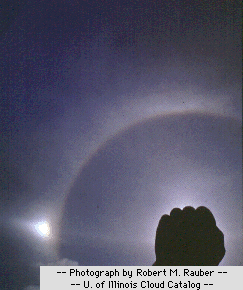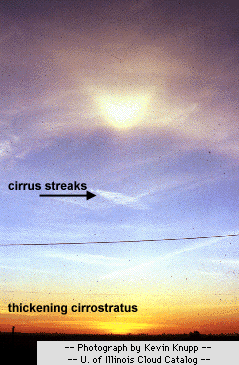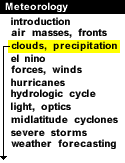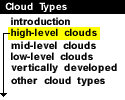
|
Cirrostratus are sheet-like, high-level clouds composed of ice crystals. Though cirrostratus can cover the entire sky and be up to several thousand feet thick, they are relatively transparent, as the sun or the moon can easily be seen through them. These high-level clouds typically form when a broad layer of air is lifted by large-scale convergence.

Photograph by: Rauber |
Sometimes the only indication of their presence is given by an observed halo around the sun or moon. Halos result from the refraction of light by the cloud's ice crystals. Cirrostratus clouds, however, tend to thicken as a warm front approaches, signifying an increased production of ice crystals. As a result, the halo gradually disappears and the sun (or moon) becomes less visible. |
When the sun is low on the horizon, cirrostratus clouds can appear in a magnificent array of colors as longer wavelengths of sunlight (red, yellow, and orange) are reflected off of the clouds.

Photograph by: Knupp |
The cirrus streaks in this photograph are aligned in a southwest to northeast direction, indicative of warmer air advancing at higher levels. Lower on the horizon, thickening cirrostratus clouds effectively hide the sun, signifying changing weather ahead. As the warm front approaches, these clouds will thicken and be replaced lower and more dense cloud types. |

cirrus |
|

Mid-Level Clouds |





